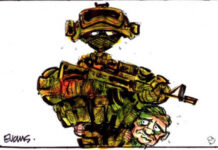IT ALL SEEMS so long ago now, and, to be fair, in human terms, 48 years is a long time. New Zealand was a different country in 1974. Someone unafraid of courting controversy might say it had achieved “Peak Pakeha”. Although the Labour Government of Norman Kirk had struck out boldly in the direction of a truly independent foreign policy: recognising “Red China”, and sending a New Zealand frigate to “observe” (but really to protest) the French nuclear testing at Mururoa Atoll, this was still a very “European” place. In the South Island, particularly, the two largest cities – Christchurch and Dunedin – had been built to look as though they were founded in the Middle Ages – not the mid-Nineteenth Century.
Born and bred in the South Island, I had not been back there since 1969, when the family moved to Heretaunga in the Hutt Valley. Barely 18, and in search of – well, I wasn’t quite sure – I boarded the Union Steamship Company’s inter-island express steamer, the TEV Rangatira, and sailed south to Lyttleton. Yes, that’s right, Lyttleton. Forty-eight years ago it was still profitable to run a ferry service a wee bit further than Picton. I’ve seen many beautiful places since that journey in 1974, but none of them could match for sheer wonder sailing up Lyttleton Harbour on a brisk Autumn morning as the sun came up behind the Rangatira’s stern and bathed the hills and houses in a magical golden light.
Magical, yes, that’s the word. Magic is what this essay is about. The magic of art and memory.
It was on that journey south, in the autumn of 1974, that I first encountered George Dunlop Leslie’s mysterious painting, “In A Wizard’s Garden”. It was hanging in the Robert McDougall Art Gallery, situated behind the Canterbury Museum in Christchurch’s splendid Botanic Gardens. Leslie’s painting stopped me in my tracks. The room in which it hung was deathly quiet, I was the only person in it, and I felt myself drawn to it like Edmund and Lucy in C.S. Lewis’s “Voyage of the Dawn Treader”. The melancholic gaze of the young woman, the painting’s principal subject, held me spellbound. Who was she? Where was she? And who was the dark figure entering through the garden’s narrow gate?
I can’t remember registering the artist’s name. If I did, then I soon forgot it. But the painting itself, its eerie stillness and its disconcerting sense of menace – that I did not forget. Passing through Christchurch many times in the latter half of the 1970s, I always made my way to that quiet room, and to the half-sad, half-challenging gaze of the young woman in the garden, and to the dark figure who kept her there.
Until the day came when I entered the quiet room and found the painting had been replaced by another. Not unusual, of course, for art galleries to rotate the works in their collections, but I was devastated. Leslie’s work had become a kind of talisman, a corporeal reminder of a time in my life when magic seemed very close. It’s removal struck me as both a judgement and an instruction: time to put away childish things. But, the child in me preferred Leonard Cohen’s poetry:
Magic is afoot
It cannot come to harm
It rests in an empty palm
It spawns in an empty mind
But Magic is no instrument
Magic is the end
And so the years passed, and New Zealand changed, and I changed with it. Magic seemed very far away indeed in the narrower and more materialistic nation we had become. If I thought of the painting at all, it was only as a symbol of what had been lost. Our culture had become much less European and much more global in its focus. This was thought to be a good thing. A better thing, though, was the indigenous culture of the Māori, unfurling from the cracks in the colonisers’ concrete, and shimmering with a magic all its own.
And then, just a few weeks ago, I saw it. No more than a tiny circle of colour beside Lynda Clark’s Twitter handle, but the human brain is a marvellous thing and mine instantly recognised the sad figure of the young woman in the red dress. Not hesitating for a moment, I messaged Lynda and shared with her my longstanding fascination with the image she had chosen. Turns out I wasn’t the only person enchanted by Leslie’s painting: Lynda, too, had visited it whenever she could, transfixed, like me, by the young woman’s gaze.
It was Lynda who supplied me with the artists name and the painting’s title. (I had thought it was called “The Magician’s Garden” – which was close, but not close enough for Google Images!) With the correct details, the Internet flooded me with images and information.
According to the Christchurch Art Gallery:
“In response to the adverse impacts and uncertainties of the industrial age, many late Victorian and Edwardian British artists were drawn to somewhat escapist historical or literary themes. Lavishly displaying this tendency, George Dunlop Leslie’s In the Wizard’s Garden was first shown at the Royal Academy in 1904, and in New Zealand at the 1906–07 Christchurch International Exhibition. Because the painting puzzled visitors, Leslie was asked for an explanation of its meaning. Its unhappy subject was a young medieval noblewoman who had sought an alchemist or wizard’s guidance to discover the secrets of the future. The theme originated from American writer Nathaniel Hawthorne’s ‘Rappacini’s Daughter’, a macabre tale featuring a garden filled with poisonous plants. The setting of the painting was, however, English rather than Italian: it is known to be based on Leslie’s own garden in Wallingford, Oxfordshire. London-based, former Dunedin merchant Wolf Harris, a friend of many leading artists, bought the work almost as soon as it arrived in Christchurch and then gifted it to the Canterbury Society of Arts.”
The secrets of the future, ah yes, that is the stuff of wizardry. For me, however, the joy of being able to look again into the wizard’s garden served only to unlock memories of the past. Like the works of those Victorian and Edwardian artists among whom Leslie’s skills shone so brightly, the New Zealand of 1974 strikes me now as an elaborate lie, designed to protect its Pakeha inhabitants from the “impacts and uncertainties” of their inescapably Pacific destiny.
The Christchurch I arrived in that autumn morning is no more, shaken to bits by the constantly moving tectonic plates upon which Aotearoa does its best to stand upright. “God is alive, magic is afoot”, wrote Leonard Cohen. “It moves from hand to hand”. And it is moving now. Perhaps, in her half-sad, half-challenging way, the young woman in the wizard’s garden is urging us to step, finally, beyond its enchanted walls, and discover who, and where, we really are.





Nice painting
Beautiful painting and writing.
Yes the Rangitira, I can well remember the sleeping cabin (puking all night) in 1969 after a day at Wellington zoo. But you’re not wrong, Lyttleton was sunny and magical if not just for the fact, we were getting off the damn boat!
Illusory perhaps but a much more golden time for most NZers, Maori and Pakeha alike – state houses were plentiful, work was plentiful and there was food on the table. Peak social democracy.
That is one of my favourite paintings at the Christchurch Art Gallery, I’d always look out for it when visiting the gallery. I had a print of it on my bedroom wall for a while, I’d imagine myself in the image.
The Christchurch Wizard’s garden, did you say?
I had always picked 1973 as the year Chris Trotter considered NZ was at its best and boldest.
Whereas Winston Peters thinks it was 1978.
“The melancholic gaze of the young woman, the painting’s principal subject, held me spellbound. Who was she?”
Clearly she’s a minimum wage worker, hired by said Wizard, and expected to cut his entire lawn with those piddly shears sitting by the side of the pond.
Quite frankly, I’d be melancholic too under those circumstances!
Nah you’re going to deep lolz. Tell me when the painting Burt’s out with fucking rave strobe lights to scan my thoughts and tell me things are fishy.
Bravo Chris. I enjoy your writing.
Chris Trotter
I studied art. I know my shit. That painting is a metaphor for 2023. Jacinda stares at her fate as the grim reaper enters the arena.
I studied proctology. If I can be of any help?
Your metaphors are that of a pre schooler. This is just another Greek Tragedy.
cabbage having a HJ picture book of arno breker sculptures doesn’t count as ‘studying art’
He’s an encyclopaedia salesman who’s just arrived unannounced as she ponders, did I feed the cat?
No wonder the pensive expression, he looks like Waititi.
And what’s he carrying? His prescription for your life?
Hah. But that’s treating it as a caption comment. What other relevance could it have to our future society? The dark amorphous shape – is it Tusk in drag? What feelings would it evoke if she was in a sparkly bodysuit and he was in full space travel gear?
Cabbage studying art was crayons and a numbered coloring in book for 3 year olds.
The young woman is Zealandia unaware that Roger Douglas is approaching through the gate.
The young woman would be less innocent and Roge would be in a clown-suit.
Strange how a particular memory, based on an image, can anchor us in not just the past but our own fully rounded sense of the past. I also grew up in Christchurch in the 70s and visited the McDougall Art Gallery many times. Your sense of Christchurch then is much like mine. I agree that it was almost Victorian in its culture with the school you attended being seen, in particular, as the most important social determinant.
I don’t see this as negative particularly, just the flavour of the times, and even found myself experiencing a degree of nostalgia for that flavour when visiting Invercargill.
So true Chris Trotter. ‘Who are we? Where did we come from? Where are we going?’
Our Lady has many names but the time of day is rather late.
Nevertheless we are surrounded with clues and symbols. Sometimes rather astounding like those in the video linked, set in a politically drenched old city where a beautiful, miraculous woman of the Han interprets a great Russian composer.
https://www.youtube.com/watch?v=oD5pqlDPCHc
The mysteries and romance of early life, back before we could back-check them. Sent us on into the world. Early books in my case, the great one, ‘The Naked Ape’, which established my foundation. My four siblings chose what felt warm at the time and are now lost and useful for plutocrats.
Outstanding writing Chris. Thanks for that.
If we don’t stop blasting each other over things written or done in the deep past, when the new devils take over they will put all of us through a brain wash and there won’t be any problem with these troubling thoughts. But bad things are not only in the past.
Can we try and rise above the harsh side of our natures that is buried but too often arises like vomit. In Brave New World they found a way to deal with strong emotions which were regarded as destabilisng.
‘Brave New World???’ What is it exactly that you are trying to say?
I can’t think of anything more helpful than a full understanding of the past.
The commonly used expression, “Those who ignore history are bound (or doomed) to repeat it” is actually a mis-quotation of the original text written by George Santayana (1863-1952), who, in his Reason in Common Sense, The Life of Reason, Vol.1, wrote “Those who cannot remember the past are condemned to repeat it.”
Santayana’s quotation, in turn, was a slight modification of an Edmund Burke (1729-1797) statement, “Those who don’t know history are destined to repeat it.” Burke was a British Statesman and Philosopher who is generally viewed as the philosophical founder of modern political conservatism.
Comments are closed.